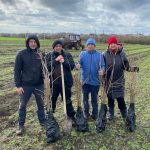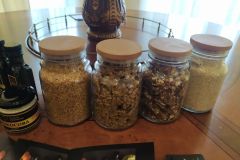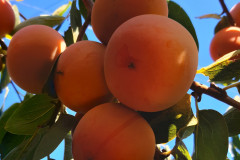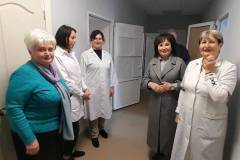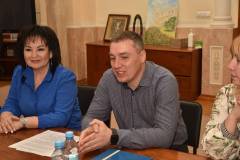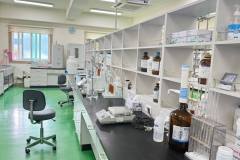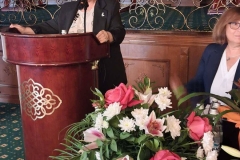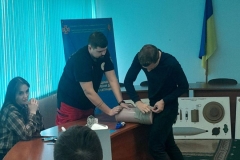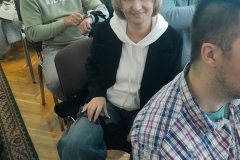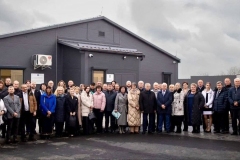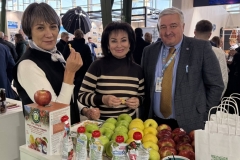Історія Інституту
History of the Institute
The Institute of Climate-Smart Agriculture of the National Academy of Agrarian Sciences of Ukraine (NAAS) was established on July 27, 2022, through the merger of the Institute of Irrigated Agriculture of NAAS, the Rice Institute of NAAS, and the Southern State Agricultural Research Station of the Institute of Water Problems and Land Reclamation of NAAS (pursuant to Resolution of the Cabinet of Ministers of Ukraine No. 1793-r of December 29, 2021, Resolution of NAAS No. 01/01 of January 26, 2022, and Order of NAAS No. 9 of February 2, 2022).
Institute of Irrigated Agriculture of NAAS
The history of the institution spans over 100 years and has always been closely associated with researchers’ efforts to find better ways to combat droughts, which, for example, occurred in the Kherson Governorate on average once every three years during the 19th century.
In the late 1880s, the idea of creating an experimental field to advance agriculture in the challenging natural conditions of southern Ukraine emerged among the faculty of the Kherson Agricultural School.
Historical periods of the institution’s development
Historical period 1889–1899
The Systematic Compilation of Resolutions of the Kherson Provincial Zemstvo Assembly, in the section Improvement of Agricultural Practices, records the following resolutions concerning the establishment and functions of the experimental field:
- The matter of organizing the experimental field was entrusted to a commission composed of elected members of the Zemstvo Assembly tasked with inspecting the agricultural school, as well as members K.V. Leonard and N.F. Sukhomlinov.
- The commission’s report on organizing the experimental field, including expenditures for setting up facilities and maintaining the field, was approved.
A second resolution to establish the experimental field was adopted on October 22, 1889, during the XXV regular meeting of the provincial Zemstvo Assembly, following the report by K.I. Tarkhov, The Importance of Experimental Fields and a Project for Organizing an Experimental Field at the Kherson Zemstvo Agricultural School. This date can be considered the beginning of the organization of the oldest experimental agricultural institution in Ukraine’s steppe zone.
The first research program focused on soil cultivation methods and developing fertilization systems within a three-field crop rotation, aiming to find ways to accumulate and preserve soil moisture, which was crucial in southern conditions. The following experiments were planned, grouped into six categories:
Group I – Effect of winter crop sowing dates (in dry soil and after moistening). Autumn plowing depth for spring crops compared to spring plowing.
Group II – Seeding rates for winter crops.
Group III – Seeding rates for spring wheat.
Group IV – Effect of sowing method and seed placement; effect of rolling and harrowing on winter and spring crop yields.
Group V – Effect of manure, phosphoric acid, and green manure on winter and spring crops. The role of autumn stubble plowing.
Group VI – Effect of different types of fallow and absence of fallow on winter and spring crop yields.
The first head of the experimental field was Konstantyn Tarkhov, a student of the Ukrainian scientist, agronomist, and soil scientist Oleksandr Izmail’skyi. His book How Our Steppe Dried Up is one of Izmail’skyi’s world-renowned works, presenting results of experimental research in the steppe zone from 1886–1893. These studies addressed the future development paths of the steppe and agriculture in the steppe zone.
One of the book’s quotes reads:
“If we continue to look carelessly at the progressive changes in the surface of our steppes, and consequently at the progressive drying of steppe soil, it is hard to doubt that in the relatively near future our steppes will turn into a barren desert.”
In 1895, the experimental field became an independent institution with its own premises, equipment, staff, and separate budget, while still remaining affiliated with the agronomic organization of the provincial Zemstvo.
Tarkhov developed special instruments, later improved by F.B. Yanovchyk, for determining the critical soil moisture level below which plants begin to wilt.
Historical period 1900–1910
“…what has been accumulated over this short period is still raw material; it will take many more years before the moment comes to transfer this raw material to another laboratory the ‘laboratory of thought’where an ‘extract’ of a certain strength and composition will be made.”
In 1900, the research program was updated and expanded by Felix Boleslavovych Yanovchyk, incorporating several important experiments aligned with the climatic conditions of the steppe zone. These included the introduction of the first nine-field grass rotation with alfalfa, and trials of winter crop cultivation between rows of maize (“American” and “Kherson” fallows). At the Kherson Experimental Field, Yanovchyk conducted the first attempts to experimentally determine the optimal sowing dates for winter wheat and spring cereals in southern Ukraine, which formed the basis for scientific and methodological recommendations on their cultivation.
From 1898 to 1912, the experimental field engaged in extensive independent activity, becoming not only a research center but also a cultural hub and a living source of new agricultural knowledge.
Historical period 1910–1929
By resolution of the Zemstvo Assembly of January 14, 1909, it was decided to rename the “experimental field” into an “experimental station.” This decision was communicated to the Department of Agriculture with a proposal to cover half of the transformation costs, and only in 1910 did the renaming take concrete effect.
Research program (1900–1916)
In the early 1920s, the station’s work program was based on:
- Combating drought: through establishing sustainable field management to prevent famine; introducing drought-resistant species and varieties into crop rotations with optimal sequencing; using the vegetation period efficiently; growing late-maturing row crops; developing and applying tillage techniques aimed at moisture accumulation, conservation, and rational use.
- Maintaining and restoring soil fertility.
- Studying crop rotation, intensive land use, and farming systems (comparing crop rotations, studying elements of crop alternation, occupied fallows, etc.).
- Cultivation of fodder crops in arid climates.
- Agricultural intensification (cultivation of row crops, introduction of reclamation and irrigation, use of floodplains, development of melon growing, etc.).
From 1924 to 1931, the station was headed by the renowned agrobiologist Pavlo Pidhornyi, who was also the author of the textbook Crop Production. In one of his works, he wrote:
“The most important factor for obtaining yields in the dry steppe, where it is constantly in deficit, is soil moisture. All technical practices aimed at preserving and accumulating it in the soil give a certain increase in the yields of all crops without exception.”
Under his leadership, research on artificial irrigation of crops began, and already in 1924, the station established a department of irrigated crops.
In May 1924, a department for outreach and liaison with the agronomic organization and the population of the steppe zone was created at the experimental station.
History of the Institute
The Institute of Climate-Smart Agriculture of the NAAS was established on July 27, 2022, through the merger of the Institute of Irrigated Agriculture of the NAAS, the Rice Institute of the NAAS, and the Southern State Agricultural Research Station of the Institute of Water Problems and Land Reclamation of the NAAS (pursuant to the Order of the Cabinet of Ministers of Ukraine No. 1793-r dated December 29, 2021, Resolution of the NAAS No. 01/01 dated January 26, 2022, and Order of the NAAS No. 9 dated February 2, 2022).
Institute of Irrigated Agriculture of the NAAS
The institution’s history spans more than 100 years and has always been connected with researchers’ search for better ways to combat droughts, which, for example, occurred in the Kherson Governorate on average once every three years during the 19th century.
In the late 1880s, among the teaching staff of the Kherson Agricultural School, the idea emerged to establish an experimental field to develop agriculture in the challenging natural conditions of southern Ukraine.
HISTORICAL PERIODS OF THE INSTITUTION’S DEVELOPMENT
Historical Period 1889–1899
The Systematic Collection of Resolutions of the Kherson Provincial Zemstvo Assembly, in the section “Improvement of Agricultural Culture,” contains the following decisions regarding the establishment and functions of the experimental field:
- The issue of organizing the experimental field was assigned to a commission composed of elected assembly members tasked with inspecting the agricultural school, as well as members K.V. Leonard and N.F. Sukhomlinov.
- The commission’s report on establishing the experimental field, including expenses for arranging premises and maintaining the field, was approved.
The second resolution to establish the experimental field was adopted on October 22, 1889, during the 25th regular session of the provincial zemstvo assembly, following the report by K.I. Tarkhov “The Importance of Experimental Fields and a Project for Organizing an Experimental Field at the Kherson Zemstvo Agricultural School.” This date can be considered the beginning of the organization of the oldest agricultural research institution in the steppe zone of Ukraine.
The first research program focused on soil cultivation techniques and fertilizer systems within a three-field crop rotation, aimed at finding ways to accumulate and conserve soil moisture — a matter of critical importance in the south. The planned experiments were divided into six groups:
Group I — Effect of sowing dates for winter crops (into dry soil and after moistening); autumn plowing depth for spring crops compared with spring plowing.
Group II — Seeding density for winter crops.
Group III — Seeding density for spring wheat.
Group IV — Effect of sowing methods and seed placement, as well as rolling and harrowing, on the yield of winter and spring crops.
Group V — Effect of manure, phosphoric fertilizers, and green manure on winter and spring crops; role of autumn stubble cultivation.
Group VI — Effect of different types of fallow, and absence of fallow, on the yield of winter and spring crops.
The first head of the experimental field was Konstantin Ivanovich Tarkhov, a student of the Ukrainian scientist, agronomist, and soil scientist Oleksandr Oleksiiovych Izmail’skyi. His book “How Our Steppe Dried Up” became internationally recognized, containing results of experimental studies in the steppe zone from 1886–1893. These studies addressed future development paths for the steppe and agriculture in the region.
One quotation from this book reads:
“If we continue to carelessly watch the progressive changes in the surface of our steppes, and with them the progressive drying of steppe soils, it is hardly doubtful that in the not-too-distant future our steppes will turn into a barren desert.”
In 1895, the experimental field became an independent institution with its own premises, equipment, staff, and budget, though still associated with the agronomic organization of the provincial zemstvo.
Tarkhov developed special devices, later improved by F.B. Yanovchyk, to determine the critical soil moisture level below which plants begin to wilt.
Historical Period 1930–1956
Since the 1920s, the country had been searching for regions suitable for cotton cultivation, driven by the government’s desire to achieve textile independence. The development of cotton production was expected to promote the growth of the machine-building, textile, clothing, chemical, and pharmaceutical industries.
One such region was southern Ukraine, where cotton had previously been grown only on small plots as part of initiatives by individual researchers. In 1924, scientists of the Kherson Agricultural Research Station began studies on cotton cultivation under the conditions of southern Ukraine.
By 1930, cotton fields in Ukraine covered 20,000 hectares, stretching from Odesa to Mariupol. By 1934, the area had increased eightfold. The Soviet Union ranked fourth among the world’s largest cotton producers, after the USA, India, and China.
With the expansion of cotton cultivation in southern Ukraine, the Kherson Agricultural Research Station was reorganized in 1931 into the Kherson Zonal Cotton-Growing Station under the People’s Commissariat of Agriculture of the USSR.
By decree of the Council of People’s Commissars of the USSR No. 175 of February 1, 1935, the Ukrainian Research Cotton-Growing Station was established on the basis of the Kherson Zonal Cotton-Growing Station.
The growth of cotton cultivation in southern Ukraine stimulated the development of irrigation. At that time, irrigated land in the Ukrainian SSR was expanding, primarily allocated for strategic cotton production. Between 1930 and 1955, the station’s scientists developed agronomic practices for cotton cultivation, conducted breeding work to create varieties adapted to the steppe zone of Ukraine, and studied the effectiveness of irrigation for cotton crops.
Notable scientists working at the station during this period included S.D. Lysogorov, M.M. Horyanskyi, I.Yu. Pidkopai, S.M. Pidozerskyi, and S.O. Hladkov. Serhii Lysogorov is regarded as the founder of the modern school of irrigated agriculture. Mykola Horyanskyi authored the textbook Cotton Growing (1940) and Methodological Guidelines for Conducting Field Experiments on Irrigated Lands (1965, 1970).
In the postwar years, with the construction of large irrigation systems, cotton was given priority among agricultural crops. This created the need for a specialized research institution to address issues of cotton cultivation in southern Ukraine. In accordance with the Resolution of the Council of Ministers of the USSR No. 1114 of March 19, 1949 “On Measures for the Development of Cotton Growing in Non-Irrigated Regions” and the Order of the USSR Ministry of Agriculture No. 242 of March 25, 1949, the Kherson Agricultural Research Station was reorganized into the Ukrainian Research Institute of Cotton Growing.
In 1949, the organizational and operational structure of the Institute consisted of 10 departments: administration; agronomy and crop rotations; agrochemistry; plant physiology; cotton breeding and seed production; forage crop breeding and seed production; economics; publishing; plant protection; mechanization; and a fiber technology laboratory.
The Research Institute of Cotton Growing was a regular participant in the All-Union Agricultural Exhibition and was awarded first-class diplomas.
In 1951, the Institute began admitting postgraduate students in the specialties “Agronomy,” “Breeding and Seed Production,” “Plant Protection,” and “Mechanization.” From 1954, “Plant Physiology” and “Agrochemistry” were added to the list of specialties.
Starting in the mid-1950s, agricultural priorities in the region shifted toward grain and forage crops. With the expansion of irrigated lands in the traditional cotton-growing regions of Central Asia and Transcaucasia, cotton gradually disappeared from southern Ukraine. The Institute of Cotton Growing was subsequently reoriented toward the development of irrigated agriculture in Ukraine.
Historical Period 1956–1979
With the construction of large irrigation systems in southern Ukraine and the return of cotton cultivation to Central Asia, there arose a need to establish the Ukrainian Research Institute of Irrigated Agriculture (UkrRIIA). The Institute was founded in accordance with the Resolution of the Council of Ministers of the USSR No. 253 dated February 19, 1956. Its primary mission was to develop farming systems for irrigated lands.
In 1956, the structure of UkrRIIA included: the Administrative Department; Departments of Economics, Agro-Soil Science, Irrigation, Agrochemistry, Mechanization, Agrotechnics, Plant Breeding and Seed Production, and Plant Protection.
During its first fifteen years, the Institute’s scientists developed advanced irrigation methods for major crops, as well as cultivation technologies for winter wheat, barley, vegetables, sugar beet, and maize.
In 1966, a Rice Department was established. The success of the national rice industry owes much to the research of UkrRIIA scientists (B. I. Laktionov, L. S. Zhurbinа, A. A. Kachan).
From 1963 to 1979, the Institute was headed by a prominent scholar in land reclamation and irrigated agriculture, Oleksandr Sobko, Corresponding Member of the NAAS. Under his leadership, the Institute achieved national recognition. During this period, the settlement of Naddnipryanske was developed, the facility was equipped with modern instruments, and opportunities for young scientists expanded.
Annual republican meetings on the cultivation of grain and leguminous crops in southern Ukraine were held at UkrNDIIZ. Foreign agricultural delegations visited the Institute to exchange best practices.
For significant achievements in developing and implementing progressive irrigation methods for agricultural crops, the Ukrainian Research Institute of Irrigated Agriculture was awarded the Order of the Red Banner of Labour by the Decree of the Presidium of the Supreme Soviet of the USSR on January 26, 1971.
In 1972, the first breeding center in the Soviet Union dedicated to developing crop varieties and hybrids for irrigated conditions was established at U UkrRIIA. Breeding programs focused on winter and spring wheat, maize, soybean, and alfalfa.
In 1970, the Institute hosted an All-Union conference on soybean cultivation on irrigated lands. In May 1974, at the XII International Grassland Congress in Moscow, the Institute, represented by O. O. Sobko and S. P. Holoborodko, presented the report “Creation and Use of Irrigated Cultural Pastures in the Southern Steppe of Ukraine” and took first place among all research institutions engaged in forage production for irrigated lands.
In July 1974, USSR Minister of Agriculture D. S. Polyansky paid a working visit to UkrRIIA. He expressed satisfaction with the alfalfa experimental plots and the scientific achievements of the Forage Production Laboratory.
For more than 20 years, the Institute coordinated all scientific research on irrigated agriculture in Ukraine.
Starting in 1974, all institutions conducting research under irrigation conditions reported their results to the Institute’s Coordination and Methodological Council, which significantly improved the scientific level of studies on irrigated lands in southern Ukraine.
During the 1960s–1970s, the Institute’s scientists advanced the theoretical foundations of irrigated agriculture and made a substantial contribution to Ukrainian agronomic science through the development of:
- Fertilization systems for crops in grain–grass–row crop rotations of the grain–forage type on irrigated lands, ensuring high productivity and soil fertility preservation (I. M. Popova, S. S. Raievska, A. H. Pryshchepa, A. P. Shkribtiienko, I. D. Filipiev, V. V. Hamaiunova, A. V. Melashych, R. S. Osidchenko, V. I. Kryshtopa);
- The first recommendations for improving the reclamation state of solonetz soils on irrigated lands using agronomic, biological, and chemical measures (K. E. Burzi, N. V. Krasutska, B. I. Laktionov, O. P. Safonova);
- Integrated crop protection systems against pests, diseases, and weeds for irrigated and rainfed lands in rotations of various specializations with minimal chemical load on plants (I. Yu. Pidkopai, H. P. Naidionov, V. F. Saveliev, A. K. Lysenko, T. I. Prodchenko, O. D. Sheludko);
- Water meters and outlets for flexible pipelines for surface irrigation methods, and the first design of a self-propelled bridge-cultivation machine with interchangeable tools for irrigation, fertilizer application, ameliorant incorporation, and soil slotting (I. F. Honcharov, P. V. Matsko, V. I. Malashkin, H. N. Atsekhovskyi);
- Highly efficient technologies (for the time) for cultivating tomatoes, onions, cabbage, carrots, and other vegetables (A. S. Symonov, H. F. Kiver, B. O. Beniukh, V. V. Vasiuta, Ye. M. Hor-batenko);
- Seed production technologies using biotechnological methods for active plant recovery from viral infections when obtaining initial material, as well as a double-harvest method for its subsequent multiplication (Ye. H. Abrashyna, M. S. Boiko, I. P. Buhaieva).
From the mid-1960s, scientists I. I. Andrusenko, V. H. Semma, M. M. Horianskyi, and V. S. Krupko worked on designing crop rotation schemes for irrigated agriculture in southern Ukraine, establishing optimal crop ratios and return frequencies.
In 1965, D. A. Shtoiko developed a formula for calculating soil moisture consumption based on average daily temperatures and relative air humidity.
By 1970, the Institute’s researchers had developed irrigation regimes for winter wheat that increased yields by 25–30% and for sugar beet by 15–20%, while significantly saving irrigation water. Throughout the 1970s, existing irrigation regimes for major crops were actively improved (V. A. Pysarenko, Yu. M. Rohovyi):
- Differentiated systems of primary tillage by method and depth for crop rotations on lands of various ecological–technological groups and reclamation status (V. I. Ostapov, O. F. Fesenko, Yu. M. Chornoostrovets, A. M. Melnychuk, M. P. Maliarchuk);
- Environmentally safe cultivation technologies for winter and spring wheat, winter barley, grain sorghum, maize, millet, buckwheat, and soybean (A. H. Bilous, O. O. Sobko, V. I. Zavieriukhin, L. S. Zhurbina, I. T. Netis, S. O. Zaiets);
- Optimal multi-component mixtures for post-harvest, after-cut, and green conveyor crops (V. T. Barylnyk, M. A. Lytvyn, A. H. Shapoval, M. P. Isichko, et al.);
- Agronomic techniques to increase the productivity of alfalfa and grass–legume mixtures for green fodder and hay (O. O. Paniukova, S. V. Yavorskyi, M. A. Lytvyn, L. D. Vasylenko).
In 1969, at the Institute’s “Kopani” experimental farm, the first irrigated cultural pasture covering 107 hectares was established (S. P. Holoborodko).
Historical Period 1979–1988
From 1979 to 1988, the Institute was headed by Volodymyr Ivanovych Ostapov. During this period, the institution employed nearly 500 staff members and conducted extensive research aimed at improving existing and developing new resource-saving technologies for cultivating agricultural crops.
This was the period with the largest number of research units in the Institute’s history.
Scientific departments and laboratories of the Ukrainian Research Institute of Irrigated Agriculture (1987):
- Department of Perennial Grass Breeding
- Department of Plant Immunity, Physiology, and Protection
- Department of Soil Reclamation
- Department of Patent and Licensing, Invention, and Innovation Activities
- Department of Vegetable and Potato Growing
- Department of Agrochemistry
- Department of Primary and Elite Seed Production
- Department of Intensive Forage Production
- Laboratory of Pastures, Meadows, and Forage Crop Seed Production Technology
- Maize Breeding Laboratory
- Wheat Breeding and Genetics Laboratory
- Soybean Breeding Laboratory
- Laboratory of Mathematical Modeling of Intensive Crop Cultivation Technologies
- Laboratory for Coordination and Implementation of Scientific Work
- Laboratory of Cereal Crop Cultivation Technology
- Plant Biochemistry and Grain Quality Laboratory
- Irrigation Equipment and Mechanization Laboratory
- Laboratory of Chernozem Irrigation Regimes
- Irrigation Regimes Laboratory
- Crop Rotation Laboratory
- Soil Tillage Laboratory
- Weed Control Laboratory
- Industrial Crop Cultivation Laboratory
- Maize and Sorghum Cultivation Laboratory
- Production and Construction Department
- Administrative Personnel
- “ UkrRIIA” Experimental Farm
- Support Staff
The results of the Institute’s research extended beyond the borders of the Soviet Union. In 1976, in Varna (Bulgaria), at a CMEA meeting on irrigation research programs for 1976–1980, Dr. Ivan Davydovych Filipiev participated on behalf of Ukraine. In 1979, he visited France to study methodological approaches to programming and achieving high crop yields.
Researchers V.I. Zaveryukhin and V.M. Kolot collaborated with the Institute of Plant Breeding and Acclimatization (Radzików, Poland), exchanging expertise in soybean breeding. The Institute annually hosted dozens of foreign delegations. Within international cooperation programs on alfalfa breeding, scientists from the UK, Czechoslovakia, Poland, Yugoslavia, and other countries visited the Institute. On such occasions, the main building displayed three flags of the USSR, the Ukrainian SSR, and the visiting country.
Close cooperation was maintained with foreign colleagues, particularly through CMEA projects, focusing on “Development and implementation of highly efficient, partially and fully automated irrigation systems to intensify agricultural production on irrigated lands while preserving and enhancing soil fertility.”
In 1981, Mikhail Gorbachev, a member of the CPSU Central Committee Politburo and Secretary responsible for agricultural affairs in the USSR, visited the Institute. He inspected crop fields, reviewed the infrastructure, listened to researchers’ presentations, and expressed strong support for further implementation of scientific developments in irrigated agriculture.
The Institute solidified its status as a model research institution of southern Ukraine. In the irrigated lands of the southern oblasts during the 1980s, high-yield varieties were cultivated, including: alfalfa (Khersonska 7, Khersonska 9, Nadezhda), soybean (Khersonska 1, Khersonska 2, Khersonska 8), winter wheat (Khersonska 153), and maize hybrids (Tavriya TV, synthetic Naddnipryanska 50) developed by the Institute’s breeders.
Extensive studies were conducted on programmed yield levels for winter wheat (6.0, 7.0, and 8.0 t/ha) and maize (8.0, 9.0, and 10.0 t/ha). The introduction of these technologies in collective and state farms in southern Ukraine demonstrated high efficiency — by 1977, they were applied to 50,000 hectares, and in 1978–1980, to 80,000–90,000 hectares.
Joint research with the Southern Ukrainian Machine Testing Station, the Ukrainian Research Institute of Vegetable and Melon Growing, and the All-Union Research and Design-Technological Institute of the Canning Industry improved mechanized tomato harvesting technologies. This approach yielded 45–50 t/ha, reduced labor costs by 3–3.5 times, and increased labor productivity by 3.6 times.
The Laboratory of Southern Potato Growing developed and implemented in the southern regions of Ukraine a potato cultivation technology with programming elements, ensuring yields of 18–20 t/ha of high-quality tubers. In 1988, the Institute established a Potato Biotechnology Laboratory.
The Institute’s progressive forage production methods allowed yields of 70–80 t/ha of green alfalfa mass, 180–200 t/ha of fodder beets, 45–50 t/ha of green mass from cereal-legume mixtures, 2.5–3.0 t/ha of soy grain and 30–35 t/ha of green mass, and up to 100–140 centners/ha of green fodder when growing two to three forage crops per year. Recommendations for establishing and using irrigated cultivated pastures were applied in many farms, with 5–6 cycles per year producing 50–60 t/ha of high-quality green fodder.
Historical Period 1988–2000
In 1990, the Ukrainian Research Institute of Irrigated Agriculture (UkrRIIA) was renamed the Institute of Irrigated Agriculture of the Ukrainian Academy of Agrarian Sciences (Resolution of the Council of Ministers of the Ukrainian SSR No. 279 of September 22, 1990).
According to irrigation development projects, the irrigated land area in Ukraine was expected to reach 4 million hectares by the year 2000. However, due to land reform and market transformations in the national economy, the condition of irrigation systems deteriorated. By 1999, out of 2.6 million hectares irrigated in 1990, almost 1.5 million hectares were no longer being watered. In Kherson region, out of 471.1 thousand hectares of irrigated land, only 379.9 thousand hectares were actually irrigated.
The challenges in the agricultural sector inevitably affected the activities of the main research institution of Ukraine in the field of irrigated agriculture. On April 19, 2000, by Order of UAAS No. 39 “On the Renaming of the Institute of Irrigated Agriculture and the Subordination of the Kherson Breeding Research Station of Melon Crops”, the research institution was renamed the Institute of Agriculture of the Southern Region of UAAS (IASR UAAS).
Key Research Achievements (1980s–2000s)
During this period, the Institute conducted a wide range of comprehensive research, including:
- Economic justification of crop rotation structures for multi-sector farms operating on irrigated lands, development of short-rotation crop systems for collective, joint-stock, and private farms (Andrusenko I.I., Kovalenko A.M., Makarov L.Kh., Babenko I.O., Zhuikova K.O.).
- Soil fertility studies under irrigation and fertilization (Pysarenko V.A., Malyarchuk M.P., Fesenko O.F., Chornoostrovets Yu.M., Kotov S.B., Kovtun V.A., Ivanov I.T., Yokich D.R., Myshukova L.S.).
- Nutrient content parameters for optimal crop production and improved fertilizer rate calculations for planned yields (Filipiev I.D., Hamaiunova V.V., Melashych A.V., Dymov O.M., Vasylenko M.I.).
- Soil-conserving, water-saving tillage systems in grain–grass crop rotations, reducing fuel consumption by 20.7%, total process energy by 30%, and labor costs by 25%, while increasing productivity by 15–20%.
- Pest, disease, and weed control measures for major crops in southern Ukraine (Sheludko O.D., Prodchenko T.I., Sidenko V.P., Kosachov S.P., Pryshchepo M.M.).
- Energy-saving technologies for winter wheat cultivation on irrigated lands in southern Ukraine (Netis I.T., Zaiets S.O., Makarov L.Kh., Shukailo S.P., Chernichenko I.I.).
- Maize cultivation methods under resource-saving technology ensuring yields of 7.0–9.0 t/ha (Kryshtopa V.I., Makarov L.Kh., Kotov B.I.).
- Soybean cultivation technologies with modern plant protection and fertilizers, improving irrigation regimes and reducing resource use by 25–30% while producing 2.5–3.0 t/ha of high-quality grain (Zavieriukhin V.I., Levandovskyi I.L.).
- Energy-saving forage production systems using annual and perennial legumes and cereals, yielding 7.0–9.0 feed units/ha with 110–120 g digestible protein, reducing resource costs by 15–20%.
- Green conveyor forage systems from irrigated pastures, yielding 11,158 GJ of total energy per 1,000 livestock units (Husiev M.H., Holoborodko S.P., Yavorskyi S.V., Paniukova O.O., Barylnyk V.T.).
- Mathematical models and the “Technologist” software complex for designing resource-saving technologies and optimizing agricultural management decisions (Mikheiev Ye.K., Lysogorov K.S., Chornyi S.H., Shevtsov I.K., et al.).
- Seed potato production systems using biotechnological methods for virus-free starting material; improved cultivation techniques for food and seed potatoes in irrigated southern regions (Buhaieva I.P., Chernichenko I.I., Pidkopai I.I., Balashova H.S., Chernichenko O.O., Malyshenko V.M.).
- Environmentally friendly tomato production technologies without seedlings, yielding 40.0–50.0 t/ha while saving 20–22% of energy resources (Kiver H.F., Vasiuta V.V., Liuta Yu.O., Mortikova N.V., et al.).
- Transgressive selection principles for durum winter wheat and creation of varieties such as Mriya Khersonu, Nakhodka 7, Dnipryana, Khersonska 97, Khersonska Bezosta, Khersonska 99 (Orliuk A.P., Bazalii H.H., Honcharova K.V., Karamushka L.F., Vasylenko L.F., Zhukova L.F.).
- Sweet corn hybrids Tachanka, Borysfen 191 MV, Borysfen 433 MV, Borysfen 430 MV with yields of 11.9–14.0 t/ha (Lavrynenko Yu.O., Yanchenko A.O., Nemolovska T.B., Maslova L.H.).
- Soybean varieties UNIIOS 1 (1985), Yuh 40 (1987), Yuh 30 (1990), Vytiaz 50 (1991), Deimos (1998), Phaeton (2000) (Kоlot V.M., Petina L.V., Vorobiova V.I., Mykhailov V.O., Klubuk V.V., Kolot V.V., Murzenko I.I.).
- Cotton breeding (since 1993) resulting in varieties Dniprovs’kyi 5 (2001) and Pidozers’kyi 4 (2007) (Nemolovska T.B., Borovyk V.O., Stepanov Yu.O., Kovtun M.M., et al.).
- Alfalfa varieties Nadiia (1982), Sinska (1986), Unitro (1995), Vavilovka-2 (1996), Veselka (1998) with green mass yields of 60.0–78.0 t/ha and seed yields of 0.8–1.0 t/ha (Hasanenko L.S., Hladkov S.O., Tyshchenko O.D., et al.).
- Meadow fescue and bromegrass varieties (Zvyozdochka 3, Zvyozdochka 5, Khersonska Rannia 1, Tavriiskyi) (Svyrydov O.V., Drozd A.V., Myronova L.M., Kobylyna N.O., et al.).
- Improved elite seed production schemes under irrigation in southern Ukraine (Velychko M.H., Vlashchuk A.M., Fedorenko V.F., Khromin V.Ya., Piskun V.F., Zhuravel A.A., Malyarchuk N.I., et al.).
Historical Period 2000–2022
On 19 July 2011, the main scientific institution of Ukraine in the field of irrigated agriculture was restored to its historical name – the Institute of Irrigated Agriculture of the National Academy of Agrarian Sciences of Ukraine (Order of NAAS No. 172 “On the Institute of Irrigated Agriculture of NAAS”). At that time, it was the only scientific institution in Ukraine responsible for defining state and scientific-technical policies in the field of irrigated agriculture.
During this period, the Institute’s appearance and its adjacent territory were fundamentally modernized. The scientific developments of the Institute’s researchers have international significance and correspond to global standards. In recent years, the publication activity of the Institute’s scientists has increased significantly, with research published in international journals indexed in Scopus, Web of Science, Copernicus, and other databases.
Scientific research activity intensified, and the Institute’s developments have been implemented in production not only in southern regions but across Ukraine and abroad. Annually, the Institute and its research network hosted international and nationwide field days, scientific-practical conferences, round tables, and seminars. Leading scientists of the Institute participated in international and national forums, exhibitions, fairs, and governmental meetings at regional and national levels, actively appearing on television and radio, and disseminating research results via the Internet.
In recent years, the Institute’s researchers developed and implemented in production:
- An optimized structure of sowing areas with crop rotation on irrigated and non-irrigated lands, applied annually on 700–800 thousand hectares in Kherson region, as well as energy-saving differentiated soil tillage systems using chisel and disc implements, applied on irrigated and non-irrigated lands of the southern region (R.A. Vozhegova, A.M. Kovalenko, M.P. Malyarchuk, M.V. Novokhizhniy, H.H. Tymoshenko, P.V. Pysarenko, S.O. Zayets, L.Kh. Makarov, et al.);
- Scientifically substantiated short-rotation crop sequences for grain production suitable for agricultural enterprises and farms with limited land resources, widely employing energy-saving soil-protective tillage systems, reducing fuel consumption by 20% and process energy intensity by 40% (R.A. Vozhegova, A.M. Kovalenko, M.P. Malyarchuk, P.V. Pysarenko, O.Ye. Markovska, A.S. Malyarchuk, L.S. Myshukova, et al.);
- Technologies for cultivating winter wheat, sunflower, winter barley, soybean, triticale, sorghum, oil flax, and millet (I.T. Netis, S.O. Zayets, V.I. Netis, L.I. Onufran, O.A. Kovalenko, K.S. Fundirat, et al.);
- Resource-saving fertilization systems based on optimal soil nutrient parameters and agro-meliorative measures (I.D. Filip’iev, A.V. Melashych, O.P. Safonova, H.M. Isakova, O.S. Vlashchuk, A.V. Tomnytskyi, I.O. Bidnina, O.A. Shkoda, T.A. Martynenko, V.V. Kozyriev, O.M. Dymov, et al.);
- Tomato cultivation technologies using proprietary varieties in the technological process: Kimmeriets, Sarmat, Naddniprianskyi-1, Legin, Kumach, Inhuletskyi, Time (Yu.O. Liuta, N.P. Kosenko, V.V. Vasiuta, Yu.O. Stepanov, et al.);
- Technologies for growing fodder crops and improving natural forage lands (S.P. Holoborodko, O.D. Tyshchenko, M.H. Husiev, S.V. Yavorskyi, et al.), including seed production of pasture grasses applied annually in the Institute’s state farms;
- Water-saving irrigation regimes for crops, providing savings in irrigation water and energy resources while generating 7–8 thousand UAH of net profit, applied across farms in Kherson, Mykolaiv, Dnipropetrovsk, Zaporizhzhia, Luhansk, and Donetsk regions on more than 500 thousand hectares (V.P. Pysarenko, M.P. Malyarchuk, P.V. Pysarenko, S.V. Kokovikhin, L.S. Myshukova, O.S. Suzdal, V.H. Pilyarskyi, O.O. Pilyarska, et al.);
- Creation of soft and hard winter wheat varieties, maize hybrids, soybean varieties, alfalfa and perennial grasses, and innovative potato seed production technologies, as well as the only medium-maturing white sweet clover variety “Pivdennyi.”
During this period, the honorary title “Honored Scientist of Ukraine” was awarded to I.T. Netis (2009), I.D. Filip’iev (2010), A.P. Orliuk (2011), R.A. Vozhegova (2012); the title “Honored Worker of Agriculture of Ukraine” was awarded to V.L. Nikishenko (2009) and S.P. Holoborodko (2014). Corresponding Members of NAAS included Yu.O. Lavrinenko (2007) and R.A. Vozhegova (2016).
Young scientists awarded Cabinet of Ministers of Ukraine scholarships included A.I. Perchets, T.Yu. Marchenko, O.O. Netreba, D.P. Voitashenko, I.O. Bidnina, O.O. Pilyarska, S.O. Yuziuk. S.P. Holoborodko received the State Scholarship for Outstanding Scientists of Ukraine.
By recent years, the Institute employed 120 staff, including 64 scientists: 10 Doctors of Science (including 2 NAAS academicians) and 37 Candidates of Science. The Institute served as the leading entity for implementing NAAS State Research Program 45 “Irrigated Agriculture,” with researchers executing 56 tasks across 18 PND NAAS projects. Based on fundamental and applied research, the Institute developed and implemented:
- Irrigated agriculture systems using innovative technologies for crop cultivation, optimized irrigation regimes, fertilization, soil tillage, and plant protection (R.A. Vozhegova, M.P. Malyarchuk, P.V. Pysarenko, A.M. Kovalenko, A.S. Malyarchuk, et al.);
- Scientific approaches to increasing productivity of irrigated agrocenoses and comprehensive modeling of production processes (R.A. Vozhegova, M.P. Malyarchuk, P.V. Pysarenko, S.V. Kokovikhin, L.M. Hranovska, et al.);
- Methodological approaches for integrated assessment of irrigated lands for rational use, prevention of degradation, soil fertility protection, and restoration (R.A. Vozhegova, S.V. Kokovikhin, M.P. Malyarchuk, L.M. Hranovska, O.V. Morozov, P.V. Pysarenko, I.O. Bidnina, A.V. Tomnytskyi, V.V. Kozyriev, D.O. Bulyhin, et al.);
- Resource-saving and environmentally safe cultivation technologies for diverse crops (A.M. Kovalenko, S.O. Zayets, Yu.O. Lavrinenko, P.V. Pysarenko, S.P. Holoborodko, et al.);
- Scientifically grounded approaches to public-private partnerships in water management, including instruments of state support and regulation for irrigated agriculture enterprises (R.A. Vozhegova, L.M. Hranovska, S.V. Kokovikhin, O.V. Morozov, I.M. Biliaieva, O.M. Dymov, L.V. Boyarkina, V.H. Pilyarskyi, O.O. Pilyarska, et al.);
- Scientifically justified sowing area structures and crop rotations for rational land use and prevention of soil degradation (M.P. Malyarchuk, L.M. Hranovska, A.M. Kovalenko, S.V. Kokovikhin, O.V. Morozov, et al.).
In recent years, the Institute’s plant breeders created and registered 75 new plant varieties and hybrids in Ukraine, including soft and hard winter wheat, soybean, maize, alfalfa, tomato, cereals and legumes, and white sweet clover.
The Institute served as the scientific support center for agricultural production in Kherson region, maintained close ties with agricultural enterprises, water management organizations, and farms, and implemented innovations in production. Together with agrarian universities, research institutions, and agricultural enterprises, the Institute established the Southern Educational-Scientific-Production Consortium, chaired by Director R.A. Vozhegova.
Institute representatives participated in the Coordination Council for the restoration and development of irrigation and drainage in Ukraine, established by the Ministry of Agrarian Policy and Food of Ukraine to adapt the sector to market economy conditions and halt its decline.
The Institute provided training of highly qualified personnel under a 2016 license in Agrarian Sciences, specialty 201 – Agronomy. In 2019, doctoral studies were launched in this specialty. A Specialized Academic Council K 67.379.01 operated within the Institute, authorized to review and conduct defenses for the degree of Candidate of Agricultural Sciences in 06.01.05 – Breeding and Seed Production.
The scientific research of the Institute forms the scientific and technical foundation for crop production on irrigated and non-irrigated lands in Ukraine. The Institute’s cultivation technologies have been applied on approximately 500,000 hectares of irrigated and over 3.5 million hectares of non-irrigated land in southern Ukraine. The Institute operates a modern seed production facility, providing the southern region with high-quality basic and pre-basic seeds.
The Institute was a member of the European Integrated Gene Bank System (AEGIS) and maintains Ukraine’s only comprehensive cotton collection, comprising 282 samples. Researchers collaborate with institutions in Turkey, Israel, USA, China, Kazakhstan, Turkmenistan, Armenia, Belarus, Moldova, Bulgaria, and companies including BASF, Syngenta, Monsanto, RAGT, Agro Dilo, among others.
As a result of long-term scientific work, the Institute was awarded the Order of the Red Banner of Labour on 26 January 1971, 18 gold, 12 silver, and 8 bronze medals, certificates from the Verkhovna Rada and the Cabinet of Ministers of Ukraine, and international awards, including the ESQR’s Quality Achievements Awards 2017.
In 2022, by merging the Institute of Irrigated Agriculture of NAAS, the Rice Institute of NAAS, and the Southern State Agricultural Research Station of the Institute of Water Problems and Land Reclamation of NAAS (according to Cabinet of Ministers of Ukraine Resolution No. 1793-r dated 29.12.2021, NAAS Resolution No. 01/01 dated 26.01.2022, and NAAS Order No. 9 dated 02.02.2022), the Institute of Climate-Smart Agriculture of NAAS was established.
Rice Institute of NAAS
The Central Committee of the Communist Party of Ukraine, in Resolution No. 1120 dated September 25, 1962, “On the Development of Rice Cultivation in Southern Ukraine,” recognized the necessity of widely expanding rice irrigation systems in order to reach 15,000 hectares under rice crop rotations and 9–10,000 hectares under rice cultivation by the end of 1965, including 1,500 hectares in spring 1963. For the Skadovsk Experimental Station of the Ukrainian Research Institute of Irrigated Agriculture, 1962 marked the beginning of introducing rice in saline soil regions as a reclamation crop for solonetzic soils and as an important reserve for increasing grain production in southern Ukraine.
On June 11, 1963, the Central Committee of the Communist Party of Ukraine and the Council of Ministers of the Ukrainian SSR adopted Resolution No. 703 “On the Construction of Irrigated Rice Systems in the Zone of the Krasnoznamyansky and North Crimean Canals in 1963–1966.” Clause 5 of this resolution stated: “To develop scientific research on rice cultivation and elite seed production, the Ministry of Agriculture of the Ukrainian SSR is to reorganize the Skadovsk Experimental Station of the Ukrainian Research Institute of Irrigated Agriculture into a Rice Experimental Station, assigning it responsibility for scientific research on rice breeding, seed production, agronomic practices including crop rotations, fertilizer systems, irrigation regimes, and weed control.” Clause 7 instructed the Ministry of Production and Procurement of Agricultural Products of the Ukrainian SSR to:
- transfer 100 hectares of irrigated land from the state farm “Skadovsk-90,” adjacent to the station, for scientific research and seed production;
- organize multiplication of higher reproduction rice seeds obtained by research institutes across all rice-growing farms for systematic variety renewal.
The need for a specialized rice research institution arose due to the necessity of providing scientific support to rice-growing farms that emerged after the construction of engineered irrigation systems in the Krasnoznamyansky and North Crimean canal zones.
The rice system at the station was completed and commissioned in 1963, covering 645 hectares with a seven-field rice rotation, in accordance with Resolution No. 44 of the Council of Ministers of the Ukrainian SSR dated January 20, 1959, “On the Construction of Experimental Rice Rotations on Saline Lands in the Black Sea Zone.” Funding was provided from the limit approved by the project meeting of the Krasnoznamyansky Irrigation System.
Resolution No. 156 of the Central Committee of the Communist Party of Ukraine dated February 8, 1964, “On Measures for the Effective Use of Irrigated Lands and Improvement of Water Management Construction in the Ukrainian SSR,” and Resolution No. 808 of the Council of Ministers of the Ukrainian SSR dated August 4, 1964, allowed the organization of a state farm-technical school to train highly qualified rice specialists.
Due to the remote location of the Experimental Station and the lack of paved roads, in 1964 the station was relocated to Antonivka village—the central farm of the newly established state farm-technical school—where it continued its development.
By that time, the station had three departments: Agronomy, Breeding and Seed Production, and Agro-Soil Science. With the expansion of rice cultivation on solonetzic soils of the Black Sea and Sivash regions, research on rice breeding and seed production began. Collection and competitive nurseries sowed varieties from the Kuban, Far East, Uzbek, and Voznesensk rice research stations. The standard varieties adopted were early-maturing Dubovsky 129, mid-maturing Donskoy 63, and mid-late Krasnodarsky-424.
In 1965, rice breeding work began at the station under the leadership of Lidiya Oleksiivna Kucherenko, who defended her dissertation for the Candidate of Agricultural Sciences degree during this period. In 1971, she was invited to work at the All-Russian Rice Research Institute (Krasnodar, Russia), where she later became a leading specialist. Over the years, the department was headed by Yuriy Mykolayovych Mudryi, Valeriy Mykhailovych Sudin, Raisa Anatoliyivna Vozhegova, and Dmytro Vasylovych Shpak, all of whom made significant contributions to breeding and the creation of new rice varieties.
Due to the rapid expansion of rice cultivation areas and specific agro-climatic conditions, by order of the Ministry of Reclamation and Water Management of the Ukrainian SSR No. 530-n dated November 28, 1968, the Skadovsk Experimental Rice Station was renamed the Ukrainian Research Rice Station, and by Order No. 119 dated December 7, 1968, the associated state farm-technical school was named “State Farm-Technical School of the Ukrainian Research Rice Station.”
Scientific management of rice cultivation and the adoption of advanced agronomic practices enabled stable high rice yields across Ukrainian farms. From 1965 to 1968, average rice yields in Kherson Oblast reached about 6.4 t/ha. In 1968, Ukrainian rice farms produced 138,100 tons, and in 1969—143,600 tons. Between 1961 and 1969, more than 52,000 hectares of rice systems were constructed and commissioned in Ukraine, establishing it as a new rice-growing region. The station also began promoting scientific achievements and advanced farming practices to accelerate adoption in production.
The first breeding result at the station was the submission of the medium-maturing variety Ukraine 1 for state varietal testing in 1969 (authors: Kucherenko L.O., Smetanin O.P., Mazur T.H., Mosina S.B., Krasnook N.P.), followed by the medium-maturing variety Ukraine 3 in 1970 (authors: Kucherenko L.O., Smetanin O.P., Mazur T.H., Mudryi Y.M., Kantur M.O.).
From 1979, the station was led by Anatoliy Antonovych Vantsovskyi, Honored Agronomist of Ukraine. Under his leadership, over 20 new rice varieties were developed and submitted for state testing, 13 of which were entered into the State Register of Plant Varieties of Ukraine. Over 30 patents and authorship certificates were obtained, and more than 600 scientific works were published.
The most productive years for significant scientific developments were 1986–1996.
From 1980, rice areas in Kherson decreased, reaching 2,000 hectares by 1998, while in Odesa Oblast they covered 14,000 hectares. Public opinion, along with the so-called desalination and pollution of the Black Sea near Skadovsk, contributed to this decline. Therefore, new rice cultivation technologies had to be developed to grow rice on low-productivity lands while creating favorable environmental conditions. In 1990, such an ecologically safe, herbicide-free technology was developed, ensuring economically justified yields of 3–3.5 t/ha.
Following the Presidium of the Academy’s resolution in 1992, approved by the Cabinet of Ministers of Ukraine on March 26, 1992 (No. 4336), and by order of the Ukrainian Academy of Agrarian Sciences No. 100 dated April 14, 1992, the Ukrainian Research Rice Station was renamed the Rice Experimental Station of UAAS.
Since 1992, under the National Center for Plant Genetic Resources of Ukraine, the station began working on the introduction, formation, study, and inclusion of rice accessions from the National Collection into breeding programs. Today, a passport database of the rice gene pool has been formed, including 712 rice accessions from 27 countries (Asia, Far East, Europe, China, Japan, Italy, USA, Ukraine, and other countries). Valuable trait donors identified in these studies serve as breeding material. The best 18 rice accessions are registered in the NCGRU.
During the difficult transition period, the station’s leadership preserved rice lands from privatization, maintained rice systems, and substantiated the feasibility of domestic rice cultivation. Order No. 14-4-19 dated February 15, 1994, “On the Status of Lands Allocated for Experimental Fields and Regulation of Relations Between Research Institutions and Their Experimental Farms,” strictly prohibited privatization of Academy-assigned lands.
In 1994, to improve seed production and increase high-quality seed availability, the Association of Rice-Growing Farms “Agro-Elita” was established, including rice farms from Crimea and Kherson Oblast, led by Vantsovskyi A.A.
The station’s research achievements have been recognized both nationally and internationally. Kherson rice was noted as a high-quality product. In 2002, Ukraine, represented by the Rice Experimental Station, joined the Mediterranean Rice-producing Countries Association (MRCA) under FAO, enabling participation in international scientific projects, conferences, and ecological studies.
The Presidium of UAAS, by resolution on November 27, 2003 (Protocol No. 21), transformed the Rice Experimental Station of UAAS into the Rice Institute of UAAS to enhance research and implement scientific achievements in production.
Since 2006, the Institute has been led by Candidate of Agricultural Sciences Volodymyr Viktorovych Dudchenko, whose main focus is developing integrated systems for rice protection against diseases, pests, and weeds. He is also President of the Association “Rice Producers,” uniting scientific and production potential to create high-quality, competitive Ukrainian rice. Under his leadership, environmentally friendly rice cultivation technology was developed, the seed production system reorganized, fully meeting domestic industry needs for high-quality seeds.
The Rice Institute has received numerous awards: International Academic Rating “Golden Fortune” Diploma (2002), National Contest “Highest Standard” Diploma (2003), Honorary Diploma “Leader of Agro-Industrial Complex 2004,” Euro Market Quality Certificate, and many others.
In 2008, the Institute hosted the International Scientific Conference “Solutions for Rice Cultivation in Temperate Agroecosystems,” attended by 127 scientists from Russia, Kazakhstan, Japan, Hungary, Romania, France, Greece, Italy, Egypt, and Ukrainian research institutions and universities.
During land reform and implementation of the Presidential Decree “On Land Shares Transferred to Collective Agricultural Enterprises,” more than 1,300 owners received land rights. Rice irrigation systems, as production assets, were transferred to municipal ownership. Unfortunately, systems under private ownership have often been underutilized, overgrown, or degraded, causing soil salinization and fertility decline.
In 2008, scientists developed methodological recommendations: “Rice Cultivation Technology Considering Environmental Protection Requirements in Ukrainian Farms”, approved by the Ministry of Health and the State Environmental Safety Administration of Kherson Oblast. Production trials in Crimea confirmed its high ecological, technological, and economic efficiency, achieving yields of 6–7 t/ha while saving resources and costs.
The Institute collaborates with domestic and international partners, including research institutions, commercial entities, and specialists from Russia, Japan, Austria, Denmark, Switzerland, Germany, Italy, Greece, Egypt, Romania, Poland, and Kazakhstan.
In 2010, by Presidential Decree No. 8, the Ukrainian Academy of Agrarian Sciences received national status, and the Rice Institute of UAAS was renamed the Rice Institute of NAAS.
Following Presidium resolution No. 12 (July 21, 2010), the sectoral program “Rice of Ukraine 2010–2015” was developed, aiming to: activate 5,000 hectares of unused rice irrigation systems; restore 10,000 hectares of internal irrigation networks; increase rice sowing areas to 30,000 hectares; raise rice production by 50%; expand rice product assortment; and increase elite seed production.
Today, the Institute includes the Departments of Technology and Breeding, Laboratories of Plant Protection, Seed Production, Agro-Melioration Monitoring and Agricultural Product Quality, and a Sector for Marketing Research, Intellectual Property, and Economic Analysis.
The Institute has published over 970 scientific works, including the catalog “Agro-Biological Characteristics of the National Rice Collection”, recommendations “Botanical Classification of Oryza sativa L.”, and the unified classifier of the genus Oryza. A classifier-handbook “Identification of Rice Traits” is in preparation.
The Institute participates in the international project EPGRIS (European Plant Genetic Resources Infrastructure), standardizing national databases and integrating collections into EURISCO.
Recent breeding efforts focus not only on yield but also on grain type, size, 1,000-grain weight, and rice milling quality, producing varieties such as Ukraine-96, Dniprovskiy, Zubets, Slavutych, with primary seed production for rapid implementation.
Over its history, 40 Candidate of Sciences dissertations have been defended at the Institute. The Institute’s dedicated, skilled, and persistent staff, supported by the Academy and regional authorities, has successfully maintained and developed Ukraine’s domestic rice industry.
Analysis of rice production dynamics in Ukraine shows that after a decline in 1995–2004, production began to increase. Yields rose to 5–6.2 t/ha, and total production increased from 80,000 tons in 2004 to 169,900 tons in 2011, with significant contribution from the Institute’s scientists.
Southern State Agrarian Research Station of IVPIM NAAS
The Kherson Melon Breeding Research Station was established in June 1969 based on a decision of VASKhNIL to expand scientific research and comprehensively address the development of melon cultivation in southern Ukraine. It became the first research institution in Ukraine dedicated to the development of melon crop varieties and hybrids, as well as the creation of cultivation technologies.
According to the decree of the Council of Ministers of the Ukrainian SSR dated May 13, 1969, No. 422-r, the first division of the Yu.A. Gagarin state farm, with a total land area of 1,427 ha (arable land – 1,260 ha, pasture – 95 ha, shelterbelts – 19 ha, residential plots for staff – 25 ha, other lands – 28 ha), was transferred to the Kherson Melon Breeding Research Station of VNDIOB for breeding and research work.
At that time, the assortment of watermelon varieties was limited – widely known local varieties from the Melitopol district of Zaporizhzhia region were cultivated, namely “Melitopol 60” and “Rosa Yugo-Vostoka,” which were highly susceptible to fusarium wilt and anthracnose. Between 1970 and 1990, breeding efforts at the newly established station focused on increasing yield, improving fruit quality and transportability, and, most importantly, developing disease-resistant varieties.
The first developed watermelon varieties included the well-known “Tavriyskyi,” “Voskhod,” and “Snihok”; melon varieties – “Holianika,” “Tavrychanka”; pumpkin – “Khersonskyi”; and zucchini – “Zolotinka,” which later became state standards of the former USSR. The first director was appointed as Candidate of Agricultural Sciences Fedor Vasylovych Dreval. The deputy director for scientific work was Mykola Andriyovych Shepelya. The station initially had three research departments: Breeding and Seed Production – headed by V.K. Sokolova, with research associate D.I. Sokolov (invited from the Bykivka Research Station); Technology – headed by M.P. Antonyuk; Economics – headed by V.M. Shalimov. The station’s consultant was the renowned melon specialist, Doctor of Biological Sciences, Professor A.I. Filov.
In early 1991, on the initiative and proposal of the station’s staff, Dr. A.O. Lymar, a Doctor of Agricultural Sciences and professor, was appointed director. During this period, major organizational work was carried out to expand research, primarily focusing on creating new varieties. The station developed a concept for breeding melon crops to enhance the therapeutic and preventive properties of fruits, create high-oil pumpkin varieties, and develop energy-efficient cultivation technologies. Particular attention was given to studying the effectiveness of short-rotation crop sequences and improving sowing technologies to reduce manual labor costs in melon cultivation.
In 1992, the Applied Genetics Department was established at the station, positively influencing further breeding work. Between 1995 and 2000, more than 20 melon crop varieties were created. During this period, the station’s breeding team included V.P. Didenko, T.V. Didenko, V.K. Sokolova, V.V. Frolov, D.I. Sokolov, O.H. Kholodniak, O.A. Brytik, among others; technologists – O.Ya. Kashcheyev, V.I. Knysh, A.O. Lymar. Extensive work was conducted to collect a genetic pool of initial breeding material for melon crops. Key sources of genetic material came from collection and breeding samples from over 20 countries, including the USA, Turkey, and China. The work on introduction, study, maintenance, and storage of collection samples continues to this day. The collection currently includes: watermelon – 299 samples, melon – 261, pumpkin – 101, zucchini – 67, pattypan squash – 13, and others. The genetic bank created from this collection supports nearly all breeding directions.
Starting in 1991, to prevent and treat diseases related to environmental disasters, Ukraine’s first breeding work focused on creating watermelons with radioprotective properties. Thanks to their high pectin content, these varieties can bind and remove heavy metal ions, including radioactive ones, from the human body. High-pectin watermelon varieties such as “Oberih,” “Protector 2,” “Atlant,” “Novorichnyi,” and “Rizdvyanyi,” capable of being stored for up to 4 months, were created, significantly extending the period during which they can be consumed fresh.
Preliminary research results formed the basis of the National Scientific and Technical Program (NSTP) “Melon Crops” 2001–2010. Breeding work under this program followed three main directions:
- Genetic aspects of melon crop breeding.
- Ecological aspects of melon crop breeding.
- Modeling breeding outcomes.
It should be noted that a priority direction in melon crop breeding research was increasing the level of biologically valuable substances in fruits. Between 2001 and 2010, the content of pectin in watermelon fruits increased three to fivefold, carotene in pumpkin fruits increased three to fivefold, and ascorbic acid in melon fruits increased by 1.5 times. Newly developed varieties were classified into those suitable for processing and those for fresh consumption. Watermelons intended for processing into marmalade or alcohol had high sugar and pectin content, melons – high dry matter and vitamin C, pumpkins – high carotene, beta-carotene, pectin, and oil in seeds. As a result, the station developed watermelon varieties “Spasskyi” and “Khersonskyi,” melons – “Olvia,” pumpkins – “Altair,” “Pivdennyi,” “Sryi Ukrainian,” and “Universal.” Varieties for fresh consumption were divided into early-maturing multi-fruit, mid-season high-quality, disease- and stress-resistant, and late-maturing long-storing and transportable types.
Between 2011 and 2015, research focused on adaptive breeding. Given critical climate changes, particularly over the past five years, creating heat- and drought-resistant melon varieties became particularly important for southern regions. Station breeders analyzed correlations between the morpho-physiological traits of melon crops and their heat and drought tolerance. Based on physiological properties and established correlations, models for new high-yielding genotypes suitable for cultivation under extreme hydrothermal conditions of southern Ukraine were developed. Early research stages established methods for assessing relative stress resistance of melon crops in laboratory and field conditions. For each crop, osmotic pressure, temperature, and exposure to negative factors were determined, allowing classification of the studied material into resistance groups.
Station researchers, together with the Institute of Plant Physiology and Genetics of NAS of Ukraine, conducted an in-depth analysis of the current state of gene identification in vegetable and melon crops and published updated lists of genes for cucumber, watermelon, melon, and pumpkin. Concurrently, the material and technical base for breeding was improved through the acquisition of modern portable devices – electronic refractometers, glucometers, and fructometers – for large-scale analysis of key breeding chemical indicators in the field. Using these breeding methods, between 2011 and 2015, the station developed and introduced watermelon varieties “Alians,” “Charivnyk,” “Favorit,” “Arsenal,” “Serpen,” “Chumak,” the watermelon hybrid “Mandrivnyk,” and melon varieties “Prestizh” and “Fantaziia.”
Between 2016 and 2020, methods for selecting and creating new heat-resistant, agrochemically efficient watermelon genotypes adapted to cultivation in the steppe zone of Ukraine were developed. Using monoecious maternal forms, a heat-resistant heterosis watermelon hybrid suitable for intensive table production and irrigation in southern Ukraine was created. Studies were also conducted on patterns of yield formation, accumulation of dry matter, and biologically valuable substances in different subspecies of muscat pumpkin under drip irrigation.
For the first time in Ukraine, female-type flowering maternal lines were used to produce heterotic zucchini hybrids, reducing the need for manual pollination and significantly lowering seed production costs.
Station researchers, together with the Institute of Bioenergy Crops, developed a methodology for producing tetraploid maternal watermelon lines using introduction, breeding, and modern biotechnological methods. This methodology allows the production of tetraploid maternal lines for breeding seedless plants.
Additionally, between 2016 and 2020, research was conducted on watermelon plant adaptation to stress factors in the soil-climatic conditions of the southern steppe of Ukraine. The effectiveness of specific cultivation techniques, including balanced mineral nutrition and growth regulators tailored to the plant’s physiological needs during development and under environmental stress, was confirmed. Future research will continue to expand the assortment of vegetable and melon crops and provide the Ukrainian population with valuable nutritional products.



